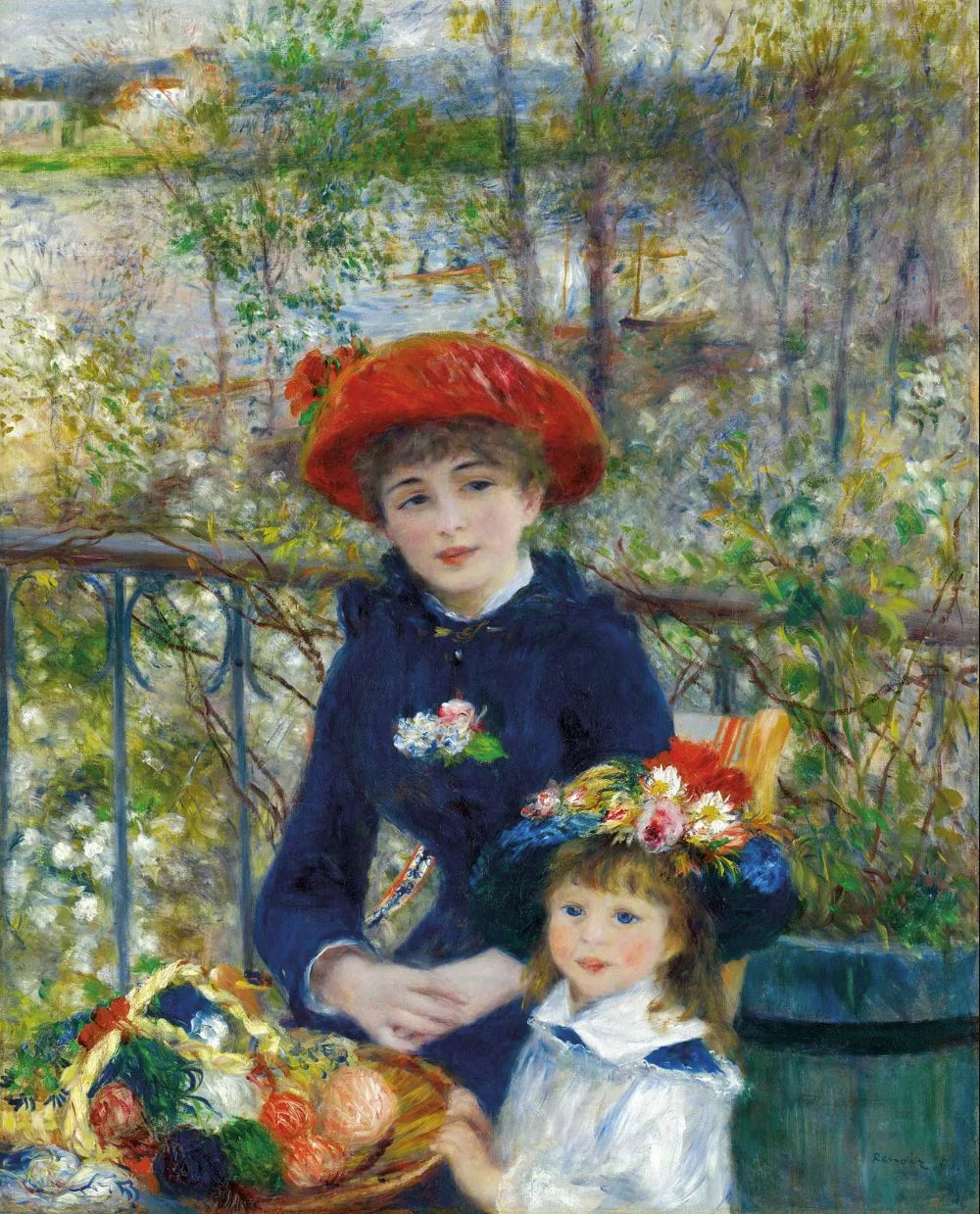
Pierre Auguste Renoir's Two Sisters: A Glimpse into 19th Century Elegance
Pierre-Auguste Renoir's "Two Sisters (On the Terrace)" stands as a hallmark of 19th-century Impressionism, capturing the essence of elegance and the fleeting moments of youth and beauty. Not merely a painting of two girls on a terrace, this work delves into the complex interplay of light, color, and emotion, characteristic of Renoir's mastery. Regarded among the most beloved pieces housed in the Art Institute of Chicago, "Two Sisters" offers a window into the vibrant Parisian life, threaded with an undeniable warmth and vivacity that Renoir portrayed through his brush.
Beyond its surface beauty, the painting encapsulates an era's spirit, marking Renoir not just as a painter of pretty scenes, but as a pivotal figure in bridging classical and modern art forms. Through an in-depth look into the genesis, historical significance, and the lasting influence of Renoir's work, we uncover the enduring charm of "Two Sisters" that continues to captivate audiences today.
Pierre-Auguste Renoir's Artistic Background
Pierre-Auguste Renoir's journey into the world of art began in the humble settings of a porcelain factory, where, at just 13 years of age, he was apprenticed. His early exposure to the art of decorating plates with floral designs laid the foundational skills that would steer his artistic direction. This early experience was crucial, as it not only honed his decorative abilities but also sparked his interest in pursuing art more seriously.
Early Education and Influences
- Academic Training: Renoir's formal art education started when he saved enough money to enroll in evening courses at the École des Beaux-Arts. He also took painting lessons under Charles Gleyre, a Swiss painter influenced by Neoclassicism. Though Gleyre's strict academic style did not entirely appeal to Renoir, it provided him with essential skills in drawing and anatomy.
- Influential Encounters: It was at Gleyre's studio where Renoir met future Impressionist icons Alfred Sisley, Claude Monet, and Frédéric Bazille. This group, sharing a common desire to break free from traditional art forms, quickly bonded and began exploring new artistic avenues together.
Development of a Unique Style
- Exploration with Light and Color: In the late 1860s, Renoir, alongside Monet, began experimenting with painting en plein air (outdoors), which led them to discover that shadows were not merely black or brown but reflected the colors of their surroundings. This realization was pivotal in developing the lighter, more vibrant palette that would come to define Impressionism.
- Influences from Other Artists: Renoir's style also evolved through the influence of other artists. He admired the colorism of Eugène Delacroix, the luminosity of Camille Corot, and the realism of Gustave Courbet and Édouard Manet. His early works displayed a blend of these influences, using color to enhance luminosity and realism in his depictions.
Commitment to Impressionism
- Founding of the Impressionist Movement: After facing rejection from the traditional Salon, Renoir, along with Monet and other contemporaries, founded an independent artists' society. This group, later known as the Impressionists, aimed to capture modern life through their art, focusing on everyday people and scenes.
Through these formative years, Renoir's artistic background was marked by a blend of traditional influences and revolutionary practices. He navigated through various styles and educational experiences, which collectively contributed to his unique approach to painting, eventually establishing him as a pivotal figure in the Impressionist movement.
Genesis of 'Two Sisters (On the Terrace)'
In the spring of 1881, Pierre-Auguste Renoir embarked on creating one of his most enchanting works, "Two Sisters (On the Terrace)." This painting, known also as "Les Deux Sœurs" and "On the Terrace," was crafted on the idyllic terrace of the Maison Fournaise, a popular dining spot located on an island in the Seine at Chatou. The setting was a favorite of Renoir, who was captivated by its vibrant atmosphere and picturesque scenery.
The Setting and Inspiration
- Location: The Maison Fournaise in Chatou, a venue frequented by Parisians for leisure and relaxation, provided the perfect backdrop. Its terrace offered views of the flowing Seine and lush surroundings that inspired Renoir.
- Atmosphere: The ambiance of the location during the spring of 1881, with its blooming flora and lively river scene, played a crucial role in setting the tone of the painting.
Composition and Models
- Jeanne Darlot: An 18-year-old aspiring actress, posed as the elder sister. Her thoughtful expression and elegant attire contribute significantly to the painting’s charm.
- Unknown Model: The younger sister, whose identity remains a mystery, adds an air of spontaneity and youthfulness to the scene.
Artistic Process
Renoir’s approach to this painting was meticulous. He began the artwork in April 1881, as noted during a conversation with American painter James McNeill Whistler. The painting was a technical marvel, showcasing Renoir’s skill in juxtaposing solid, life-like figures against a dreamy, almost fantastical landscape. This blend of realism and impressionism was further highlighted by the vibrant colors and dynamic brushstrokes used to depict the lush surroundings and the youthful subjects.
Acquisition and Titles
The painting quickly caught the attention of Paul Durand-Ruel, a prominent art dealer who purchased it for 1,500 francs by July of the same year. It was Durand-Ruel who decided on the title "Two Sisters," despite the models not being related, a decision that added an intriguing layer of narrative to the visual experience.
This piece not only reflects Renoir’s impeccable ability to capture the essence of his subjects but also serves as a vivid depiction of the leisurely lifestyle of suburban Paris in the late 19th century. The painting remains a testament to Renoir’s mastery in portraying light, emotion, and everyday elegance.
Historical Significance within the Impressionism Movement
- Visible Brushstrokes: Renoir's painting "Two Sisters (On the Terrace)" exemplifies the Impressionist technique of using visible, unmixed brushstrokes. This method contrasts sharply with the smooth blending typical of earlier styles, allowing for a more vibrant, dynamic representation of light and color.
- Color and Light: Impressionists like Renoir revolutionized the use of color by opting for a palette that reflected the true effects of light on surfaces. This approach is evident in "Two Sisters," where the color of objects is influenced by the surrounding light, creating a more lifelike and immediate visual experience.
- Everyday Subject Matter: Aligning with Impressionist themes, the painting portrays an everyday scene of middle-class leisure, a departure from the grand historical or mythological scenes often favored by academic art. This focus on the quotidian aspects of human life marked a significant shift in the content of Western art.
Impressionism's Broader Impact
- Breaking Conventions: Impressionism challenged the strict conventions of the French art world. By the time "Two Sisters" was exhibited at the seventh Impressionist exhibition in 1882, Renoir and his peers had established a new paradigm that prioritized an artist's impressions of the world over the faithful reproduction of reality.
- Innovations in Composition: Renoir's composition in "Two Sisters" blends a sophisticated figure-ground relationship with a loose, expressive landscape, showcasing his ability to harmonize detailed human portraiture with a freer, more atmospheric background.
- Promotional Strategies: The strategic exhibitions and the renaming of the painting for different audiences played a crucial role in promoting Impressionist art. By engaging with the art market through figures like Paul Durand-Ruel, Renoir helped ensure the commercial and critical success of the movement.
These elements collectively underscore the historical significance of "Two Sisters (On the Terrace)" within the Impressionist movement, illustrating how Renoir’s work not only embraced but also advanced the innovative principles of his time.
Renoir's Influence on Modern Art
- Foundations for Fauvism and Cubism: Renoir’s techniques and style were instrumental in laying the groundwork for major French movements like Fauvism and Cubism. His focus on color, composition, and depth influenced key modernist figures such as Henri Matisse and Pablo Picasso.
- From Impressionism to Modern Visual Idioms: Renoir, alongside Monet, was pivotal in evolving painting from traditional Impressionism to creating modern visual idioms, marking a significant transition in the art world.
Influence on 20th-Century Artists
- Impact on Picasso and Matisse: Renoir’s blend of modernity and tradition resonated with later artists like Picasso and Matisse. His approach to composition and color theory contributed significantly to their artistic development and practices.
- Legacy in Art Collections: Many renowned 20th-century artists, including Pierre Bonnard and Maurice Denis, were collectors of Renoir’s works, showcasing his lasting impact on generations of artists.
Artistic Techniques and Their Evolution
- Juxtaposition and Composition: Renoir’s ability to juxtapose solid, life-like figures against fantastical landscapes influenced the way modern artists approached their subjects and settings.
- Revolutionizing Color and Light: His innovative use of color and light not only defined Impressionist art but also set a precedent for the use of these elements in modern art, impacting how artists depicted realism.
Commercial Success and Artistic Recognition
- Prominent Exhibitions and Sales: Renoir’s works were widely recognized and financially successful during his lifetime, culminating in significant public and private acquisitions, such as the purchase of "Two Sisters (On the Terrace)" by Annie Swan Coburn for a notable sum, demonstrating the high regard for his art in the commercial sphere.
These elements collectively illustrate Renoir’s profound influence on the landscape of modern art, bridging 19th-century Impressionism with the burgeoning movements of the 20th century, and cementing his legacy as a pioneer whose techniques and artistic vision continue to resonate in contemporary art practices.
Shop Mini Masters Today!
Discover Timeless Miniature Masterpieces
- Exquisite Hand-Painted Reproductions: Dive into the world of Impressionism with our extensive selection featuring reproductions of masterpieces by Monet, Van Gogh, Renoir, and Cezanne. These pieces are not just reproductions; they are a tribute to the textured brush strokes and light play that made Impressionism so beloved.
- Affordable Luxury: Experience the joy of owning a masterpiece without the hefty price tag. Our reproductions are available at prices that are well below traditional retail gallery prices, making fine art accessible to all.
- Museum Quality Frames: Enhance your art experience by adding a museum-quality frame to your purchase. Enjoy the splendor of Impressionist art in your own space, without ever needing to step into a gallery.
Transform Your Space with Impressionist Art Prints
- Capture Light and Emotion: Our Impressionist art prints focus on expressing feelings and capturing light, offering you a slice of historical beauty. Each print is designed to bring the essence of Impressionist art into your home.
- Customizable Options: With a variety of shapes, sizes, matting, and frame options, personalize your space exactly how you envision it. Our art prints allow for full customization, ensuring that each piece fits perfectly within your decor.
Special Offer on Mini Masters' Collection
- Exclusive Miniatures: Shop the Mini Masters collection exclusively at Mini Masters Art. These miniature masterpieces, including the beloved "Two Sisters on the Terrace" by Pierre-Auguste Renoir, are perfect for collectors and art enthusiasts alike. Each piece comes with a unique display easel and illuminating canopy, enhancing its visual appeal and making it a standout addition to any collection.
- Art for Every Setting: Whether it’s for a corporate office or a cozy living room, Mini Masters’ art pieces serve as captivating focal points. Their small size and detailed craftsmanship allow them to adapt to various spaces, adding a touch of elegance and artistic flair wherever they are placed.
Explore these collections today and bring a piece of history and artistry into your life with our Mini Masters!
